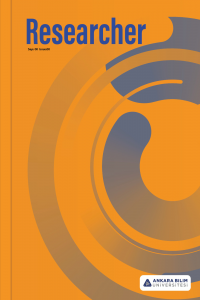Eğitim Kurumları için Robot Platformu Tasarımı ve Uygulanması
nesnelerin interneti, raspberry pi, robot platformları, robotik
Robot Platform Design and Implementation for Educational Institutions
internet of things, raspberry pi, robot platforms, robotics internet of things, raspberry pi, robot platforms, robotics,
___
- Karabulut, K., Güneş, Z., “System Design For Internet Of Things And Network Coding Applications In The Wireless Personal Area Networks” Yüksek Lisans Tezi, İstanbul Teknik Üniversitesi, Fen Bilimleri Enstitüsü, İstanbul, 2015
- Çabuk, U , Dağdeviren, O , Yiğit, Y , Süvari, M. “Gömülü Sistemler İçin Android Tabanlı Bir Mikroişlemci Programlama Yazılımı ve Arayüzü”. Bilişim Teknolojileri Dergisi , Cilt 11, No 4, Ankara, ss. 321-332, 2018
- Şişman, B., “Eğitimde Robot Kullanımı” Eğitim Teknolojileri Okumaları 2016, İşman A, Odabaşı H.F, Akkoyunlu B, Eds, TOJET. Ankara, ss.299-314, 2016
- Akçakoca, M. “Eğitim ve Araştırma Amaçlı Gezgin Robot Geliştirilmesi” Yüksek Lisans Tezi, Eskişehir Osmangazi Üniversitesi, Fen Bilimleri Enstitüsü, Eskişehir, 2017
- azgan, O., “Genel Amaçlı Bir Mobil Robot Platformun Tasarımı ve Gerçeklenmesi” Yüksek Lisans Tezi, İstanbul Teknik Üniversitesi, Fen Bilimleri Enstitüsü, İstanbul, 2008
- Gönüllü, M. K., “Mobil Robot Araştırmalarında Kullanılmak Üzere Bir Mobil Robot Platformu Geliştirmesi” Yüksek Lisans Tezi, Orta Doğu Teknik Üniversitesi, Fen Bilimleri Enstitüsü, Ankara, 2013
- Yılmaz N., Sağıroğlu Ş., Bayrak M., “Genel Amaçlı Web Tabanlı Mobil Robot: Sunar” Gazi Üniversitesi Mühendislik Mimarlık Fakültesi Dergisi, Cilt 21, No 4, Ankara, ss. 745-752, 2006
- Barrett, S. F., et al. “Using Robots to Teach Complex Real Time Embedded Systems Concepts”, Computers in Education Journal, Cilt 16, No.4, ss. 58-58, 2006
- Fang, Z., Yanhua F., Tianyou C., “A low-cost modular robot for research and education of control systems, mechatronics and robotics”, 4th IEEE Conference on Industrial Electronics and Applications, 2009
- McLurkin, J., et al. “Using multi-robot systems for engineering education: Teaching and outreach with large numbers of an advanced, low-cost robot”, IEEE Transactions on Education cilt 56 No. 1, ss. 24-33, 2013
- Bräunl, T., “Embedded Robotics: Mobile Robot Design and Applications with Embedded Systems”, Springer Science & Business Media, 2008
- Küçükkülahlı E., Güler R., “Open Source Mobile Robot with Raspberry Pi”, Balkan Journal Of Electrıcal & Computer Engıneerıng (BAJECE), Turkey, ss. 242-247, 2015
- H-S. Juang, K-Y. Lum, “Design and Control of a Two-Wheel Self-Balancing Robot using the Arduino Microcontroller Board”, 10th IEEE International Conference on Control and Automation (ICCA), Hangzhou, China, ss.634-639, 2013
- Bradbury, A., Everard, B., Learning Python with Raspberry Pi, Wiley, New Jersey, 978-1-118-71705-9, 2014
- Zhu, Y. “Embedded Systems with ARM Cortex-M Microcontrollers in Assembly Language and C: Third Edition”, E-Man Press LLC, 978-0982692660, 2017
- Williams E. “Make: AVR Programming”, Maker Media, Inc, 978-1449355784, 2014
- Nashelsky L., Boylestad R. L., “Electronic Devices and Circuit Theory”, Prentice Hall, New Jersey, 978-0135026496, 2009
- Murphy, C., Clark, R., Studholme, O., Manian, D., “Beginning HTML5 and CSS3”, Apress, New York, 978-1-4302-2875-2, 2012
- D'mello, B. J., Sriparasa, S. S., “JavaScript and JSON Essentials”, Packt, Birmingham, 978-1783286034, 2018
- Monk S., Programming Arduino Getting Started with Sketches”, McGraw-Hill Publishing, New York, 9780071784221, 2012
- Grinberg M., “Flask Web Development”, O'Reilly Media, California, 9781491991725, 2014
- Spurlock J., “Bootstrap: responsive web development”, O'Reilly Media, California, 9781449343910, 2013
- ISSN: 2717-9494
- Yayın Aralığı: Yılda 2 Sayı
- Başlangıç: 2013
- Yayıncı: Ankara Bilim Üniversitesi
İnsan Kaynakları Modellemesinde Sistem Dinamiklerinin Potansiyel Kullanımı
Sıvı Fazın Sıcaklık ve Basınç Aralığı
Beycan İBRAHİMOĞLU, Şeyma ÖNAL
Çoklu Yaya Takip Probleminin Grafik İşleme Biriminde Gerçekleştirilmesi
Eğitim Kurumları için Robot Platformu Tasarımı ve Uygulanması
Ahmet SEVİM, Alaa ELEYAN, Gülden ELEYAN
